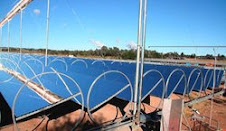Can mass transit and clean fuels solve Kenya's crisis in the capitol?
Hordes of cars, trucks plague Kenya capital
Once-gleaming city 'will come to a standstill in a decade,' warns Nairobi traffic official
Aug 04, 2008 04:30 AM
Comments on this story (1)
Malkhadir M. Muhumed
Associated Press
NAIROBI, KENYA–Vitalis Odhiambo walks 10 kilometres to work every day, wearing away the soles of his shoes along Nairobi's potholed, crumbling streets.
He doesn't do it to save the bus fare, or even the environment. He does it to save time. "If you look at the traffic jams in Nairobi, you have no option but to walk," Odhiambo said as a mass of gridlocked cars and trucks inched forward, spewing black exhaust while drivers pounded their horns. "Walking to work is faster and less stressful."
Once known as East Africa's gleaming "City in the Sun," Nairobi has become so snarled with traffic that the government estimates Kenya forfeits $460 million a year to lost productivity, fuel consumption and pollution. The congestion is threatening the economy, scaring away investors and preventing Nairobi from becoming a world-class African capital, experts say.
"We can't pretend that things are okay here," said Mutula Kilonzo, head of the Nairobi Metropolitan Ministry, an office created this year to solve the city's growing traffic and infrastructure problems. "If we don't do anything to decongest Nairobi soon, I have no doubt it will come to a standstill in a decade."
Big cities across Africa suffer maddening congestion, in most cases because they failed to update road networks built decades ago to serve colonial administrations. Lagos, Nigeria was built in the 1950s to accommodate about 60,000 people. Its current population is 14 million.
In Nairobi, the population has reached 4.7 million, up from 350,000 at independence in 1963. Private cars in Kenya have ballooned to nearly 935,000, with more than half of them in Nairobi alone, said Simon Ole Kirgotty, registrar of motor vehicles.
The roads have not grown with the times, however. A combination of bad drivers, overloaded trucks and corrupt traffic police exacerbate the problem, transforming one of Africa's biggest cities into a smoggy, gridlocked sea of cars.
There are no subways, elevated trains or bus lanes to help speed commuters to work. The roads are generally two lanes – although aggressive drivers often squeeze four lanes of cars into the narrow roads.
Minibuses known as "matatus," the main form of public transport in Nairobi, are notorious for their drivers' disregard for the law. They regularly career down the wrong side of the street to overtake cars idling in traffic, zip through red lights and screech to a stop – often in the middle of the road – to let passengers on and off. Fatal crashes are common. The punishment for such lawlessness is usually just the ire of other drivers – the poorly paid police are easily paid off.
Full article continues at TheStar.com:
Urban traffic nightmare in Kenya's capital city Nairobi
Life-changing links:
Windpower Investing, Alternative Energy Stocks
Domain Of Man - Historical Identities of Biblical Personas
Cool new search engine www.cuil.com
Clean Energy Investment Funds, Solar Power Stocks
Best Green Stocks Investing Blog
Friday, August 08, 2008
Intense Vehicle Congestion snarls Nairobi traffic
Subscribe to:
Post Comments (Atom)
Yuya Joe Blog
Lake Ontario Waterkeeper
The Daily Beast -Politics Blog
21stArch.com - 21st Century Architecture
Original Joe College Blog
WikiLeaks Foreign Policy Analysis
AGreenRealtor.com Real Estate Blog - Ecology Energy Efficiency
Best Green Stocks Investing Blog
PV Intell Photovoltaic Solar Stocks Investing
SEARCH Leading Alternative Energy and Ethical Investing websites

Custom Search
Daily Kos
Rare Earth Stocks Research
Patrick MacManus's Blog Peace and Collaborative Development
BeesTreesFrogsElephants.com - Nature and Ecology Blog
Research Green Energy stocks, Clean Energy investing information
Find wind power investing info online, clean energy mutual funds, geothermal stocks, solar energy investments.

Green Energy Investing Network:
Green Stocks Investing Clean Power Blog
SolarIntell.com Renewable Power Investing Website
Wind Intell.com Wind Energy Stocks Company Links
Geothermal Power Investing Public Companies
PV Intell.com Leading Photovoltaic Solar Energy Stocks

Custom Search
Green Energy Investing Network:
Green Stocks Investing Clean Power Blog
SolarIntell.com Renewable Power Investing Website
Wind Intell.com Wind Energy Stocks Company Links
Geothermal Power Investing Public Companies
PV Intell.com Leading Photovoltaic Solar Energy Stocks







No comments:
Post a Comment